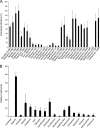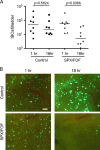Persistence of uropathogenic Escherichia coli in the face of multiple antibiotics
- PMID: 20231390
- PMCID: PMC2863638
- DOI: 10.1128/AAC.00014-10
Persistence of uropathogenic Escherichia coli in the face of multiple antibiotics
Abstract
Numerous antibiotics have proven to be effective at ameliorating the clinical symptoms of urinary tract infections (UTIs), but recurrent and chronic infections continue to plague many individuals. Most UTIs are caused by strains of uropathogenic Escherichia coli (UPEC), which can form both extra- and intracellular biofilm-like communities within the bladder. UPEC also persist inside host urothelial cells in a more quiescent state, sequestered within late endosomal compartments. Here, we tested a panel of 17 different antibiotics, representing seven distinct functional classes, for their effects on the survival of the reference UPEC isolate UTI89 within both biofilms and host bladder urothelial cells. All but one of the tested antibiotics prevented UTI89 growth in broth culture, and most were at least modestly effective against bacteria present within in vitro-grown biofilms. In contrast, only a few of the antibiotics, including nitrofurantoin and the fluoroquinolones ciprofloxacin and sparfloxacin, were able to eliminate intracellular bacteria in bladder cell culture-based assays. However, in a mouse UTI model system in which these antibiotics reached concentrations in the urine specimens that far exceeded minimal inhibitory doses, UPEC reservoirs in bladder tissues were not effectively eradicated. We conclude that the persistence of UPEC within the bladder, regardless of antibiotic treatments, is likely facilitated by a combination of biofilm formation, entry of UPEC into a quiescent or semiquiescent state within host cells, and the stalwart permeability barrier function associated with the bladder urothelium.
Figures




References
-
- Anderson, G. G., J. J. Palermo, J. D. Schilling, R. Roth, J. Heuser, and S. J. Hultgren. 2003. Intracellular bacterial biofilm-like pods in urinary tract infections. Science 301:105-107. - PubMed
-
- Apodaca, G. 2004. The uroepithelium: not just a passive barrier. Traffic 5:117-128. - PubMed
-
- Bauer, A. W., W. M. Kirby, J. C. Sherris, and M. Turck. 1966. Antibiotic susceptibility testing by a standardized single disk method. Am. J. Clin. Pathol. 45:493-496. - PubMed
-
- Bishop, B. L., M. J. Duncan, J. Song, G. Li, D. Zaas, and S. N. Abraham. 2007. Cyclic AMP-regulated exocytosis of Escherichia coli from infected bladder epithelial cells. Nat. Med. 13:625-630. - PubMed
Publication types
MeSH terms
Substances
Grants and funding
LinkOut - more resources
Full Text Sources
Other Literature Sources
Medical

